In my last blog I introduced to you the earthquakes that devastated Christchurch city beginning back in September 2010. I had been wondering about what I might share with you in my next blog and when I was driving thru the city the other day and spotted a field of wildflowers on a demolition site it occurred to me! Over 2 years on and more than 50% of the commercial buildings have been demolished in the Central Business District, the re-build is beginning and will accelerate from now onwards for the next 10 to 15 years. The demolitions have created thousands of tons of rubble and have left vacant spaces everywhere! Lots of room for carparks now……..

It will be clear from the above photo that the centre of Christchurch city now resembles something akin to what we see in many “shrinking” cities in the USA and Europe. With a difference, of course — it is only temporary. But also similar in that there are many, many open spaces (vacant lots). So what I want to tell you about is a real “nature in the city” project that exemplifies both resilience and liveability and what is so great about people, places and nature. Mary Rowe in her latest blog on the Nature of cities site states it very well in my view:
“Increasingly in the imaginative, innovative pockets of city-building there is a recognition that small, seemingly modest local initiatives aggregate up into a whole that makes a city not only more liveable, but are also critical contributors to a city’s resilience.”
 Kiwi’s (people from New Zealand — named after the iconic flightless bird) are renowned for their “will do” attitude of rolling up their shirt sleeves and getting stuck in. This project is no exception. Way back, and in amongst all the destruction and rubble and not long after the first earthquakes happened, a group of volunteers decided to bring nature back, albeit temporarily. “Greening the Rubble” was born and is now an established trust. It is a community project which unites a team of volunteers responding creatively to the extensive damage caused by the earthquakes. The reason Greening the rubble was activated so quickly after the earthquakes was because a number of people were already convinced the city was due for some remedial greening.
Kiwi’s (people from New Zealand — named after the iconic flightless bird) are renowned for their “will do” attitude of rolling up their shirt sleeves and getting stuck in. This project is no exception. Way back, and in amongst all the destruction and rubble and not long after the first earthquakes happened, a group of volunteers decided to bring nature back, albeit temporarily. “Greening the Rubble” was born and is now an established trust. It is a community project which unites a team of volunteers responding creatively to the extensive damage caused by the earthquakes. The reason Greening the rubble was activated so quickly after the earthquakes was because a number of people were already convinced the city was due for some remedial greening.
Greening the Rubble seeks to bring more biodiversity into the city and it is this urban ecology philosophy that has characterised Greening the Rubble work since its beginning To that extent, it is an experiment in urban ecology that uses private land as an outdoor laboratory. Greening the Rubble volunteers are creating temporary “pocket” parks and gardens on demolition sites, usually in commercial rather than residential streets. License agreements are made with site owners, modest financial support from these owners and extensive sponsorship of the construction materials and design process, make it possible for volunteer teams to build and maintain these parks. These sites are in public use only temporarily, until owners are ready to redevelop — which might be from six months to a few years later. A partner organisation called Gap Filler uses these and similar sites as venues for arts events, performances and installations of usually shorter duration, days or weeks.
The following has been extracted and edited from the Greening the Rubble website. Key contributors to Greening the Rubble include the site owners and:
- Members of NZ Institute of Landscape Architects (NZILA)
- Staff and students at Lincoln University and at Canterbury University including the Student Volunteer Army
- Christchurch City Council, who are the major grant source
- And a national membership charity which currently hosts the project: Living Streets Aotearoa Inc.
Examples of Greening the Rubble’s projects
Greening the Rubble’s latest temporary mini-park was in the heart of the suburb Riccarton, at Rotherham Street, surrounded by shops. It included a stage for buskers, seats (which were well used at lunchtime), plants and trees. The mural by Tess, ‘The Hope Bear’, accompanied this garden. The park is due to be dismantled and moved in a few months time. There was a celebration event there on 23 November 2012 with music from Uncle Boyle’s Jazz Triplets, led by pianist Matt Everingham. If you are interested in more, go here.

Relocatable garden (with Dance-O-Mat)
A modular design for planters and seating, built from reclaimed demolition timber, proved versatile in this relocatable garden. Below is a new set which we’ve installed on Oxford Terrace next to Gap Filler’s Dance-O-Mat. A planting of native Libertia pregrinans provides bold orange-green colour.

Food garden
At 191 Fitzgerald Ave, Christchurch, a food garden with raised beds has been constructedon the site of two demolished houses. The site owner has longer-term plans for an Arts Centre on this site, but meanwhile seeks productive use of the space, and has put water back on and is happy to allow public access under a license agreement with Greening the Rubble.


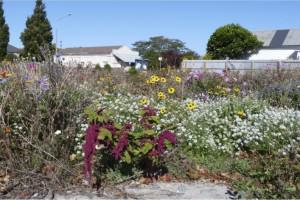
Wildflower garden
The wildflowers at the corner of Stanmore and Worcester streets, were initially seeded by a team of volunteers from a nearby town, some 80km south of Christchurch (Ashburton).
St. Asaph ‘lunch area’ beside city offices and car park
In May and June 2011 new surfaces were built using recycled on-site bricks, with added lime-chip and plants rescued from the inner city cordon by CityCare. Three steel planters containing kowhai (Sophora microphylla) trees and flaxes (Phormium tenax, on loan from the City Council) were also placed on site It was completed in July with further re-cycled materials to complete the structures and welded triangular frames for seats. In August recycled timber planks as seat tops were also added. It’s now complete.
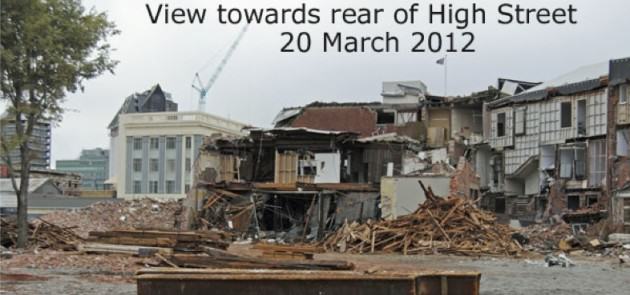

My blog would not be complete without a couple of examples from the Gap Filler team.
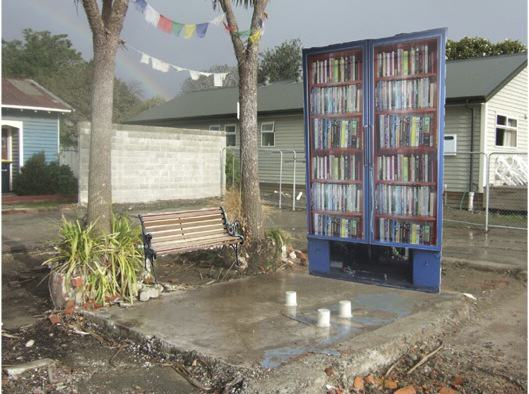
Here is an excerpt from the Gap Filler website about this “alternative” idea:
“Imagine you’ve never heard of Gap Filler. You’re walking down Barbadoes Street towards Beat Street Cafe or the Herb Centre. You’re waiting at the Kilmore intersection for the lights to change. You turn around. There’s a big fridge on the vacant site behind you. The lights haven’t changed yet. You look again. It’s not rubbish, the fridge. It’s been placed there quite deliberately. There are even paving stones leading up to it from the footpath. It’s beckoning you. So, you feel a bit silly, but you walk down the path. When you get to the fridge, you see it’s full of books. And not just any books, but great & amazing books that changed people’s lives! This is the Think Differently Book Exchange. A little note inside the fridge invites you to take a book, or come back later and leave one. Open 24 hours a day, 7 days a week, for months…!”
Dino-Sauna comes to town!
A temporary sauna was installed on the old Moda Fotografica site on 28th September 2012 for the weekend (corner Oxford and London Streets). It was tested by a small group of locals on Friday night then it was open for public use on Saturday and Sunday evenings, overseen by the locals an interested onlookers!. Sauna sessions were held for a set duration in the interests of safety.

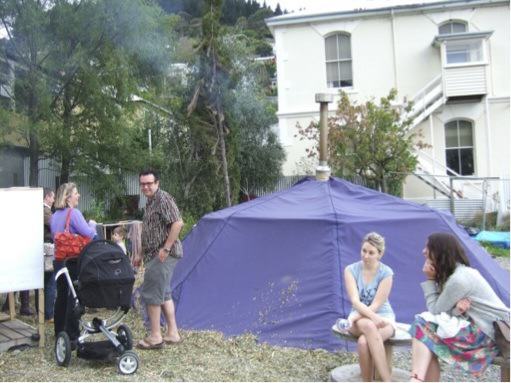
So there you have it! Creating “temporary” nature that can be shifted around the city from place to place! A prime example of resilience and liveability in an earthquake damaged city!
Glenn Stewart
Christchurch, New Zealand


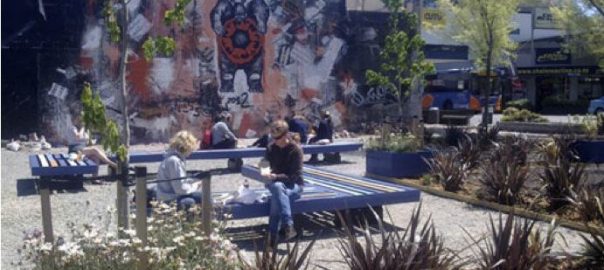

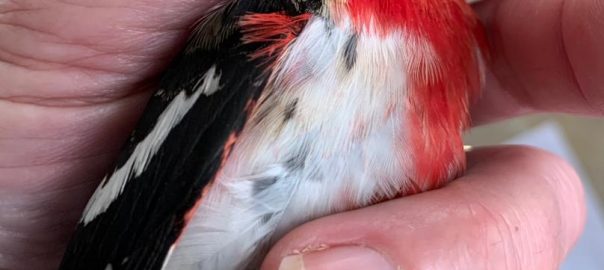


Leave a Reply